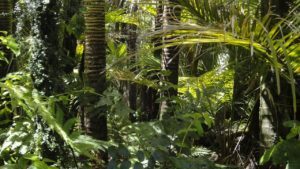
AMERICAN ASSOCIATION FOR THE ADVANCEMENT OF SCIENCE—Fossil pollen records from across the Amazon basin suggest that depopulation and resulting forest regrowth in Amazonia began centuries before European arrival and did not contribute to the observed decline in atmospheric carbon dioxide during the 17th century, according to a new study*. The results offer new insights into the human influence on Amazonian landscapes throughout history. When Europeans first arrived on the shores of South America, brutal waves of disease, warfare, slavery and genocide followed and culminated in a catastrophic loss of life that has come to be known as the “Great Dying of the Indigenous Peoples of the Americas.” It’s estimated that 90 to 95% of the Indigenous population in Amazonia died after 1492. As a result, many occupied sites were abandoned, including untold acres of previously cultivated land, which resulted in a surge of forest regrowth throughout the Amazon basin. It’s thought that this rapid regrowth may have resulted in the marked decline in atmospheric carbon dioxide (CO2) concentration that began in the early 1600s – an anomaly also known as the Orbis spike. Mark Bush and colleagues evaluated fossil pollen records from 39 sites throughout Amazonia that record changes to forest cover over the last 2,000 years. Bush et al. found that during the Great Dying period, the number of sites where forest pollen was increasing was approximately equal to those where it was falling in abundance, “effectively rejecting the hypothesis of widespread and synchronous reforestation sufficient to cause decreases in atmospheric CO2 levels,” they write. At many sites, land abandonment and forest regrowth began 300 – 600 years before the arrival of Europeans, the data suggest. While the authors note that the mechanisms driving land abandonment between 950 and 1500 years ago have yet to be identified, they suggest that the cascading effects of environmental change, pre-European pandemics, and/or social strife could have contributed. Nevertheless, Indigenous populations in some areas of Amazonia may have already been declining when Europeans arrived, a decline that was accelerated by the deadly impacts of European contact, write Bush et al.
____________________________

Rainforest regrowth occurred hundreds of years before European arrival. Rosinakaiser, Pixabay
____________________________
Article Source: AAAS news release
*”Widespread reforestation before European influence on Amazonia,” by M.B. Bush; M.N. Nascimento; C.M. Åkesson at Florida Institute of Technology in Melbourne, FL; M.N. Nascimento; S.Y. Maezumi; S.N. Huisman; C.N.H. McMichael at University of Amsterdam in Amsterdam, Netherlands; G.M. Cárdenes-Sandí at University of Costa Rica in San José, Costa Rica; H. Behling at University of Goettingen in Goettingen, German; A. Correa-Metrio at Universidad Nacional Autónoma de México in México City, México; W. Church at Columbus State University in Columbus, GA; T. Kelly at Queen Mary University of London in London, UK; F.E. Mayle at University of Reading in Berkshire, UK; C.M. Åkesson at St. Andrews University in St. Andrews, UK.
____________________________
Advertisement




